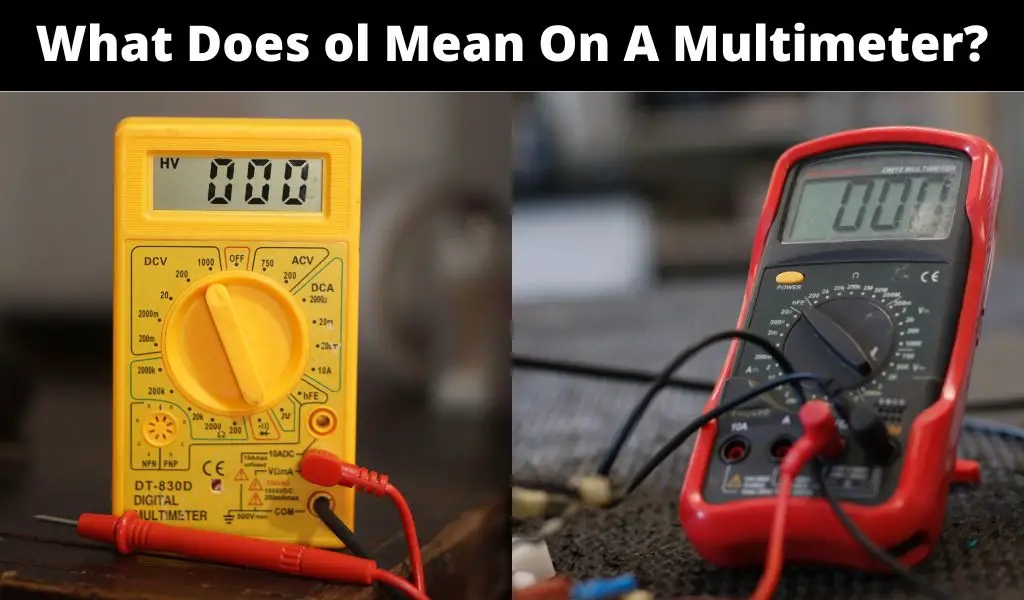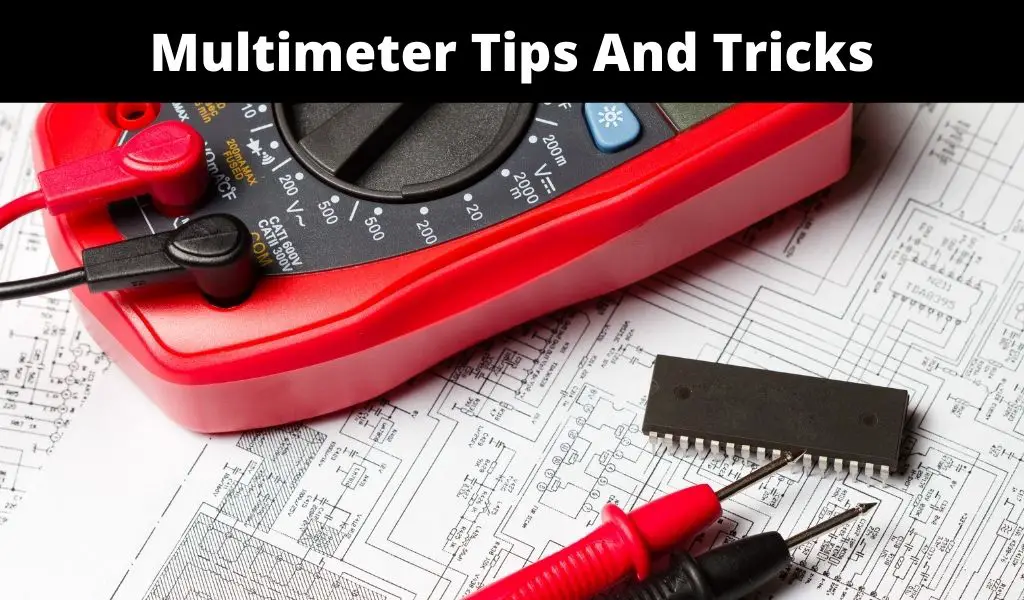If you’ve used a multimeter before, you’ve likely come across the word “OL“. What does this mean? What should you do next?
Multimeters are important tools when handling electronics or doing electronic repairs, servicing, and installations. They are mainly used for measuring AC and DC current, AC and DC voltage, resistance, and continuity.
When a multimeter gives an OL reading, this can mean several things. Let’s explore various OL meanings based on specific measurements.
I. OL Meaning When Testing Continuity
If your multimeter shows OL (open loop) or 1 when testing continuity, this simply means the test isn’t detected (no continuity). When there is no continuity, it means there is no passage or flow of electric current from one probe to the other.
An OL reading is a sign of interruption stopping the electrical signal from flowing from one probe to the other, which can mean you have connected probes badly. You should ensure you set the range selector correctly (to continuity mode).
Probes should also be placed on the test points appropriately. While doing this, check for a numerical reading. If there is no number change or the multimeter beeps continuously, the testing points are connected. The same applies If there is no change or beep.
II. OL Meaning When Testing Voltage
A multimeter that shows OL or 1 when testing voltage indicates that the voltage is either too low or out of range. OL can also mean overloaded. Generally, there is no risk of damage even in an overload.
The range selector should be set to measure V (voltage). You should also set a higher voltage range and test again. The probes should also be connected to the points properly. The connection between points being measured should be firm.
Probes are usually red and black. They should connect to the points being measured correctly i.e., points on a circuit should match the probe color.
III. OL Meaning When Testing Resistance
When a multimeter returns OL or 1 when testing resistance, it means the circuit or component being tested lacks continuity. In this case, OL indicates infinite resistance.
Before accepting the OL reading, make sure you have connected your multimeter probes properly to the right circuit (resistance circuit). What’s more, the multimeter power switch should be on with the setting at resistance ohms.
Check your reading after this and see if the resistance value falls within the ideal range for the circuit or component being tested.
IV. Diode Polarity Testing
OL can come up with other tests such as diode polarity checks where both outputs connect to each other via a resistance R. If you get an OL reading in both directions, this is an indication of an open diode.
Understanding Infinite Resistance
It’s important to understand infinite resistance on multimeters as OL appears in the presence of infinite resistance. The term describes a lack of electric current flowing through the circuit or components being measured.
To understand in-depth, consider the example of water flowing through a pipe. Resistance, in this case, is a measure of water flowing through the pipe. Clogged pipes have more resistance allowing less water through them. A pipe that is completely blocked won’t allow any water to pass through due to high resistance.
A multimeter measures resistance in the same way. Initially, a multimeter will assume there is resistance if there is no electricity flow emerging. Infinite resistance can also mean there may be a broken connection or open switch.
OL vs 0 Reading When Measuring Resistance
Background
Measuring the electrical resistance (or ohms) of a motor, compressor, or another electrical device is usually straightforward after a few attempts. However, when you get a 0 or OL reading, you can get confused. What’s the difference between 0 and OL when measuring electrical resistance?
The first, most important consideration is – everything (including switches, wires, the human body, etc.) possesses electrical resistance properties measurable in ohms via a multimeter. Some things have more electrical resistance than others.
For instance, glass, plastic, and ceramics have extremely high electrical resistance making them great insulators that restrict electricity flow.
Silver, gold, copper, and other metals like steel have low electrical resistance making them great electricity conductors. Besides conductors and insulators, there are electric loads that “sit” in between insulators and conductors.
These include things like motors, light bulbs, contractor coils, and solenoids. They are designed via thoroughly calibrated electrical resistance quantity. A specified amount of electricity runs through to do a specified amount of work if the right voltage is employed. This is where OL and 0 come in.
OL vs 0
If a multimeter returns a measurement that is close to 0 (0.5 ohms or less) or 0, this means there is very low resistance to current flow. If the current is applied, you should expect a high flow that can potentially melt wires or blow the circuit breaker.
An OL measurement is something else. Auto-ranging multimeters commonly in use today adjust automatically to a range based on what is being measured. For instance, it will adjust automatically to a high measurement range and read OL when the meter has been set to measure ohms. This is the case if the test leads aren’t connected to anything.
Air resistance can be measured between two test leads. High resistance can result in overloading, which means your multimeter has been subjected to more ohms than it can count.
When measuring between motor terminals to ground or a refrigerator compressor pipe, you should get an OL reading which indicates a lack of current flow. However, if you get 0, this can indicate the motor is dealing with a short and requires a replacement.
While there are many considerations when measuring resistance and distinguishing OL from 0, the most critical thing to remember is that 0 means short while OL means open.
How Do You Use a Multimeter?
You can’t get any accurate reading from a multimeter if you don’t know how to use one in the first place. Most importantly, there are ways of avoiding a 0 or OL reading. When you get an OL or 0 reading often, you are probably using your multimeter incorrectly.
So, how do you ensure you are using a multimeter correctly? Firstly, set the multimeter accordingly depending on what you want to measure. When measuring resistance, most multimeters will have the ohm symbol selection.
You should also learn how to connect probes. The red and black probes should be connected properly to the corresponding tips using test leads or alligator clips. After reconnection, you can read your resistance value. Disconnect the probes when you are finished and repeat the same when conducting another test.
Conclusion
OL and 0 displays are generally caused by errors. As discussed above, the multimeter display errors can be dealt with by ensuring the probes are connected properly. Alternatively, these errors can be traced to a faulty item (circuit or component).
Learning how to use a multimeter is highly recommended to avoid OL or 0 readings. Otherwise, the readings are important clues when measuring resistance, voltage, and continuity.
FAQs About OL Multimeter Reading and Related Multimeter Issues
Is an OL Reading a Good or Bad Thing?
An OL reading gives you important clues i.e., on electrical resistance. You will establish if there exists an issue with components or circuitry which can be a bad thing if it means you must take on repair work. An OL reading brought about by improper multimeter use isn’t such a bad thing since such issues can be addressed quickly.
My Capacitor Has Returned an OL Reading. What Does that Mean?
In these cases, an OL reading can mean the multimeter isn’t able to measure the current in the capacitor. You may need a higher-range multimeter. Alternatively, your capacitor may have shorted.
What Does OL Stand for in Ohms?
An OL ohms reading means the circuit is incomplete. The reasons behind this can range from broken insulation to a broken wire, faulty receptacle, or bad switch.
Can My Multimeter Test Continuity?
Yes! However, some multimeters don’t have the mode required for testing continuity. An alternative to a continuity check is to do a resistance check. If you measure less than 0.5 ohms, then you most likely have continuity in your circuit.
How Do I Reset a Multimeter?
While multimeters vary by model, resetting is as easy as turning it on/off. Some multimeters may require you to press down the power button continuously for a few seconds to reset. If your multimeter has a knob, you may be required to rotate it to zero after you reset it.
How Do You Determine an OL on a Multimeter?
Start by setting your multimeter to measure resistance. You can do this easily despite the differences in multimeter brands. After selecting the appropriate setting, install your test leads accordingly (black to the terminal labeled COM and red to the positive).
Proceed and measure/test your circuit or component. If the meter is working perfectly, connecting two leads together will result in a continuous beeping sound. If your circuit has a resistance above the measurement threshold, you will get an OL reading.






